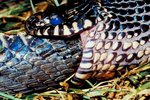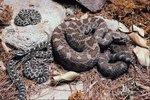
As ambush predators, pit vipers use camouflage very effectively to hide themselves from -- and sometimes lure -- their prey. These snakes usually are active at night and hide during the day. They’re characterized by spade-shaped heads, long fangs and their pit organs, located between their eyes and nostrils, which allow them to pick up infrared heat from potential prey.
Overview
Ground-dwelling pit vipers -- such as rattlers and copperheads in the United States, fer de lance and bushmasters in Central and South America, and Gaboon adders in Africa -- often have earth tones and complex patterns, which help them blend into leaves, rocks and shadows. Copperheads effectively conceal themselves in piles of old leaves, while sidewinder rattlesnakes match sandy desert floors. Pit vipers that live in trees might be much brighter to match their environments. Green eyelash vipers often conceal themselves among palm leaves, while their bright yellow relatives lurk unnoticed within bunches of bananas, and the red morphs hide in bromeliads.
Hunting
A primary reason for pit vipers’ camouflage is to conceal them from potential prey. Their pits enable them to sense warm-blooded animals -- birds, mice, rabbits, rats and even, for the massive Gaboon vipers, porcupines and antelopes -- nearby. Pit vipers also have keen eyesight, which helps them detect other food, such as frogs and lizards. The snakes remain concealed until a possible meal wanders within striking range, when they attack and inject venom through their fangs.
Lures
Some pit vipers use their camouflage to lure prey. For example, juvenile bushmasters, copperheads and cottonmouths have yellow tips on their tails, which they wriggle in a way that simulates the movement of caterpillars or worms. Would-be predators, such as larger caterpillars and frogs, lunge toward this bait, and the snakes attack. By the time these vipers reach adulthood, their tails darken to match the rest of their bodies.
Protection
Pit vipers’ camouflage also can provide protection -- which sometimes makes them more dangerous to people. The 6 1/2-foot fer de lance often conceals itself in plantations and on paths traveled by both prey animals and human workers, leading to numerous bites. On the other hand, scientists don’t know of any non-human predators that attack Gaboon adders, possibly because of how effectively these sub-Saharan pit vipers hide themselves on rainforest floors. While they’re capable of navigating on the ground, eyelash vipers rarely do, because they’re less camouflaged and therefore more vulnerable on the forest floor.
References
- Davidson College: Biology Department: General Information on Pitvipers
- The University of Georgia: Savannah River Ecology Laboratory: What Are Pit Vipers?: Whit Gibbons
- Smithsonian National Zoological Park: Friends of the National Zoo: Reptiles and Amphibians: Fact Sheets: Northern Copperhead
- Central Florida Zoo and Botanical Gardens: Florida Cottonmouth
- Northwest Florida Environmental Conservancy, Part 2: The Eastern Diamondback Rattlesnake
- University of Michigan Museum of Zoology: Animal Diversity Web: Bitis gabonica
- University of Michigan Museum of Zoology: Animal Diversity Web: Bothriechis schlegelii
- University of Michigan Museum of Zoology: Animal Diversity Web: Lachesis muta
- University of Michigan Museum of Zoology: Animal Diversity Web: Bothrops atrox
Photo Credits
-
Jupiterimages/Photos.com/Getty Images




